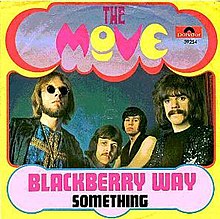Blackberry Way
| "Blackberry Way" | ||||
|---|---|---|---|---|
 German picture sleeve | ||||
| Single by The Move | ||||
| B-side | "Something" | |||
| Released | 28 November 1968 (UK) | |||
| Recorded | 1968 at Olympic Studios, London[1] | |||
| Genre | Baroque pop[2] | |||
| Length | 3:38 | |||
| Label | Regal Zonophone (UK) A&M (US) | |||
| Songwriter(s) | Roy Wood | |||
| Producer(s) | Jimmy Miller | |||
| The Move singles chronology | ||||
| ||||
"Blackberry Way" is a 1968 single by English band The Move. Written by the band's guitarist/vocalist Roy Wood and produced by Jimmy Miller, "Blackberry Way" was a bleak counterpoint to the sunny psychedelia of earlier recordings. It nevertheless became the band's most successful single, reaching number 1 on the UK Singles Chart in February 1969.[3]
The Move vocalist Carl Wayne refused to sing on the song, so Wood handled the lead vocal.[4] Richard Tandy, who later played keyboards with Wood's next band Electric Light Orchestra (ELO), played harpsichord on "Blackberry Way".[1] Despite the success of the single, the style of psychedelia-tinged pop sat uneasily with guitarist Trevor Burton. He left the group shortly after.
The B-side, "Something", was specially written for the band by David Scott-Morgan.
Wood said in a 1994 interview that "Blackberry Way" is his favourite Move song of all time, commenting that it could have been performed in any era and still worked.[4]
Personnel[]
- The Move
- Roy Wood – lead and backing vocals, guitar, sitar
- Trevor Burton – bass, backing vocal
- Bev Bevan – drums
- Additional musicians
- Richard Tandy – harpsichord
- Anonymous string orchestra
Charts[]
| Chart (1968–1969) | Peak position |
|---|---|
| Australia (Go-Set)[5] | 14 |
| Austria (Ö3 Austria Top 40)[6] | 14 |
| Belgium (Ultratop 50 Flanders)[7] | 13 |
| Ireland (IRMA)[8] | 2 |
| Italy (FIMI)[9] | 19 |
| Netherlands (Dutch Top 40)[10] | 14 |
| Norway (VG-lista)[11] | 3 |
| UK Singles (OCC)[12] | 1 |
| West Germany (Official German Charts)[13] | 7 |
Cover versions[]
- In 1969 Italian band Equipe 84 produced a cover version (with Italian lyrics by lyricist Mogol), named "Tutta mia la città" ("All the town is mine"),[14] which became a hit in Italy.[15]
- UK band The New Seekers covered this song on their 1971 album, Beautiful People (album).
- Swiss band Gotthard covered this song on their 1999 album, Open.
- US classic rockers Cheap Trick included their version of the song as a bonus track on the deluxe version of their 2017 album We're All Alright!.
References[]
- ^ Jump up to: a b "Richard Tandy Interview - April 1999 - Welcome to The ELO Network". Theelonetwork.weebly.com. Retrieved 2016-10-01.
- ^ Horning, Rob (15 February 2007). "Electric Light Orchestra: Too Much at Once Can Blow the Fuse". PopMatters. Retrieved 7 May 2016.
- ^ Roberts, David (2006). British Hit Singles & Albums (19th ed.). London: Guinness World Records Limited. p. 228. ISBN 1-904994-10-5.
- ^ Jump up to: a b Sharp, Ken (September 30, 1994). "Roy Wood: The Wizzard of Rock". The Move Online. Archived from the original on January 15, 2008.
- ^ http://www.poparchives.com.au/gosetcharts/1969/19690423.html
- ^ "Austriancharts.at – The Move – Blackberry Way" (in German). Ö3 Austria Top 40.
- ^ "Ultratop.be – The Move – Blackberry Way" (in Dutch). Ultratop 50.
- ^ https://www.ukmix.org/showthread.php?88001-Irish-Singles-charts-1967-1969/page2
- ^ http://www.hitparadeitalia.it/indici/per_interprete/am.htm
- ^ "Nederlandse Top 40 – The Move" (in Dutch). Dutch Top 40.
- ^ "Norwegiancharts.com – The Move – Blackberry Way". VG-lista.
- ^ "Official Singles Chart Top 100". Official Charts Company. Retrieved 26 January 2014.
- ^ "Offiziellecharts.de – The Move – Blackberry Way". GfK Entertainment Charts. To see peak chart position, click "TITEL VON The Move"
- ^ "Discografia Nazionale della canzone italiana". Discografia.dds.it. Retrieved 2016-10-01.
- ^ "Hit Parade Italia - Indice per Interprete: E". Hitparadeitalia.it. Archived from the original on 2013-10-14. Retrieved 2016-10-01.
- The Move songs
- UK Singles Chart number-one singles
- 1968 singles
- Baroque pop songs
- Songs written by Roy Wood
- Song recordings produced by Jimmy Miller
- 1968 songs
- Regal Zonophone Records singles